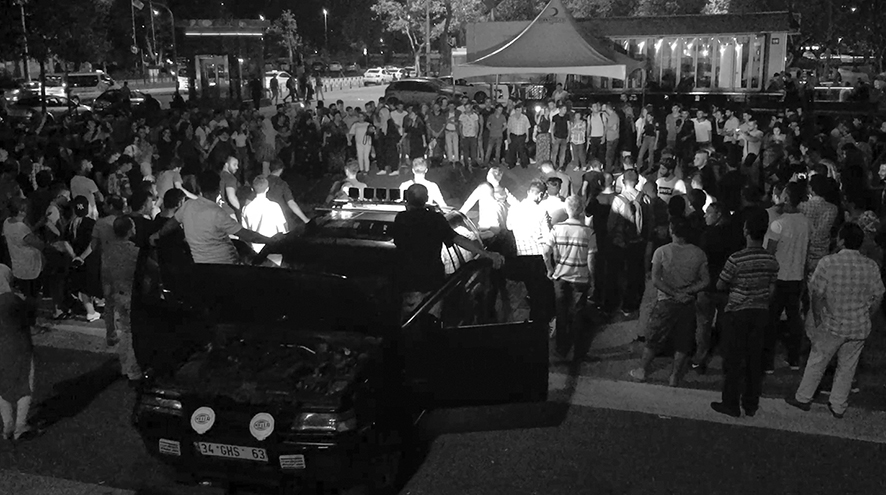‘Encounters’ investigates daily performed gestures within minority communities that operate as potential forms of communal empowerment. This piece examines the socio-political resonances between certain collectives in the territories of Catalunya and Kurdistan. ‘Encounters’ gathers multiple voices from the diasporic Kurdish Community in Europe, and the Cooperativa Integral Catalana from Barcelona (among others), in order to examine how these groups regenerate their daily sociability by creating common spaces in order to think and practice social reorganization, multiple forms of assembly and cooperation, new infrastructures of aid, insistence and resistance. Exhibited at Goldsmiths University, October 2018.
Group of Kurdish people dances at the Bosphorus shore
in Istanbul, 25th of August 2017.
.

First encounter with the Kurdish
Community Center in Haringey, London.
At approximately six o’clock in the evening on the 9th of May 2018, I was on my way to North London. My first encounter with Zilan was in the open hall of the Kurdish Community Centre where they usually hold their assemblies. We were having tea and talking, exchanging the first words. Later in the conversation when I mentioned my Catalan background, she, all of a sudden, stared at me and said: ‘In Kurdistan, we dance as a form of appearing in the public sphere. We dance as a gesture of insubordination, we dance for our martyrs, in manifestations, in weddings, and to celebrate our community. Guerrillas dance after a hard day of battling up in the mountains”. Oral storytellings, repeated gestures, chanting, and rituals are modes by which various minority subaltern groups, strengthen their sense of community and disobey the state’s repression. In this way, they develop a common language that allows them to contest the nation-state. She continued explaining that the Kurdish dance is almost always a form of circular collective dancing that consists of alternating men and women holding hands. She said that the variations of this dance in the different regions of Kurdistan mostly respond to the struggles against military occupation and state persecution that they have had to brave in recent decades. Their resistance operates between the mountainous regions straddling the borders of 5 different states and the diaspora. Dancing has become one of the collective forms of assembly and connection that embody their common political story independently of geography. Embodying resistance through performative acts is a form of inscribing a constellation of trans-local communities with similar struggles, claiming, in this way, the right to appear and yet remaining hidden. Forms of rehearsal and memorizing collective gestures become modes of remembering without having to require any visual means of representation. Thereby invoking the bonds that connect us with the past, and into the present: a rhythm passed from generation to generation.
‘Encounters’ investigates daily performed gestures within minority communities that operate as potential forms of communal empowerment. This piece examines the socio-political resonances between certain collectives in the territories of Catalunya and Kurdistan. ‘Encounters’ gathers multiple voices from the diasporic Kurdish Community in Europe, and the Cooperativa Integral Catalana from Barcelona (among others), in order to examine how these groups regenerate their daily sociability by creating common spaces in order to think and practice social reorganization, multiple forms of assembly and cooperation, new infrastructures of aid, insistence and resistance. Exhibited at Goldsmiths University, October 2018.
Group of Kurdish people dances at the Bosphorus shore
in Istanbul, 25th of August 2017.
.

First encounter with the Kurdish
Community Center in Haringey, London.
At approximately six o’clock in the evening on the 9th of May 2018, I was on my way to North London. My first encounter with Zilan was in the open hall of the Kurdish Community Centre where they usually hold their assemblies. We were having tea and talking, exchanging the first words. Later in the conversation when I mentioned my Catalan background, she, all of a sudden, stared at me and said: ‘In Kurdistan, we dance as a form of appearing in the public sphere. We dance as a gesture of insubordination, we dance for our martyrs, in manifestations, in weddings, and to celebrate our community. Guerrillas dance after a hard day of battling up in the mountains”. Oral storytellings, repeated gestures, chanting, and rituals are modes by which various minority subaltern groups, strengthen their sense of community and disobey the state’s repression. In this way, they develop a common language that allows them to contest the nation-state. She continued explaining that the Kurdish dance is almost always a form of circular collective dancing that consists of alternating men and women holding hands. She said that the variations of this dance in the different regions of Kurdistan mostly respond to the struggles against military occupation and state persecution that they have had to brave in recent decades. Their resistance operates between the mountainous regions straddling the borders of 5 different states and the diaspora. Dancing has become one of the collective forms of assembly and connection that embody their common political story independently of geography. Embodying resistance through performative acts is a form of inscribing a constellation of trans-local communities with similar struggles, claiming, in this way, the right to appear and yet remaining hidden. Forms of rehearsal and memorizing collective gestures become modes of remembering without having to require any visual means of representation. Thereby invoking the bonds that connect us with the past, and into the present: a rhythm passed from generation to generation.